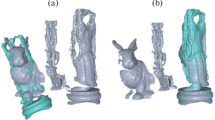Abstract
We propose a model for the recognition of unconstrained digits that may be touched with neighbor ones or damaged by noises such as lines. The recognition of such digits seems to be rather paradoxical because it requires the segmentation of them into understandable units, but proper segmentation needs a priori knowledge of the units and this implies recognition capability. To break up the loop of their interdependencies, we combine two schemes, hypothesis testing and data reconstruction, motivated by the human information system. Hypothesis is set up on the basis of the information obtained from the results of the basic segmentation, and reconstruction of the information is carried out with the knowledge of a guessed digit and then testing for its validity is performed. Since our model tries to construct a guessed digit from input image it can be successful in a variety of situations such as that a digit contains strokes that do not belong to to it, that neighbor digits are touched with each other, and that there are some occluding things like lines. The recognition results of this model for 100 handwritten numeral strings belonging to NIST database and for some artificial digits damaged by line demonstrate the potential its capacity.
Preview
Unable to display preview. Download preview PDF.
Similar content being viewed by others
References
E. Lecolinet and J. Crettez, “A grapheme-based segmentation technique for cursive script recognition,” in 1st Int’l Conf. Document Analysis and Recognition, Saint-Marlo, Frances, pp. 740–748, Sept. 1991.
R. G. Casey and E. Lecolinet, “A survey of methods and strategies in character segmentation,” IEEE Trans. on Pattern Analysis and Machine Intelligence 18(7), pp. 690–706, 1996.
X. Wang, V. Govindaraju, and S. Srihari, “Holistic recognition of handwritten character pairs,” Pattern Recognition 33(12), pp. 1967–1973, 2000.
N. Arica and F. T. Yarman-Vural, “A new scheme for o.-line handwritten connected digit recognition,” in 14th Int’l Conf. Pattern Recognition, Australia, pp. 1127–1129, 1998.
D. Yu and H. Yan, “Separation of single-touching handwritten numeral strings based on structural features,” Pattern Recognition 31(12), pp. 1835–1847, 1998.
T. M. Ha, M. Zimmermann, and H. Bunke, “Off-line handwritten numeral strings recognition by combining segmentation-based and segmentation-free methods,” Pattern Recognition 31(3), pp. 257–272, 1997.
J. Rocha and T. Pavlidis, “A solution to the problem of touching and broken characters,” in 2nd Int’l Conf. Document Analysis and Recognition, Tsukuba, Japan, pp. 602–605, Oct. 1993.
J. Rocha and T. Pavlidis, “Character recognition without segmentation,” IEEE Trans. on Pattern Analysis and Machine Intelligence 17(9), pp. 903–909, 1995.
A. Filatov, A. Gitis, and I. Kil, “Graph-based handwritten digit string recognition,” in 3rd Int’l Conf. Document Analysis and Recognition, Montreal, Canada, pp. 845–848, Aug. 1995.
K. Lee, H. Byun, and Y. Lee, “Robust reconstruction of damaged character images on the form documents,” Graphics Recognition: Algorithms and Systems, Selected Papers from 2nd Int’l Workshop on Grephics Recognition, 1997, LNCS 1389, pp. 149–162, 1998.
E. B. Goldstein, Sensation and Perception, ch. Perceiving Objects, pp. 175–213. Brooks/Cole, 5 ed., 1999.
R. L. Gregory, Eye and brain, McGraw-Hill, NewYork, 2 ed., 1973.
L. Spillmann and J. S. Werner, Visual Perception: The Neurophysiological Foundations, ch. Form Perception and Attention: Striate Cortex and Beyond, pp. 273–316. Academic Press, Inc, San Diego, 1990.
G. Kim and V. Govindaraju, “Efficient chain code based image manipulation for handwritten word recognition,” in Proc. SPIE Symp. on Electronic Image Science and Technology (Document Recognition III), San Jose, California, pp. 2660, 262–272, Feb. 1996.
C. A. Lindley, Practical Image Processing in C: Acquisition,Manipulation, Storage, pp. 424–426. Wiley press, 1991.
Z. Shi and V. Govindaraju, “Character image enhancement by selective regiongrowing,” Pattern Recognition Letters 17, pp. 523–527, 1996.
M. D. Garris, “Component-based handprint segmentation using adaptive writing style model.” NIST Internal Report 5843, June 1996.
Y. S. Chen and W. H. Hsu, “An interpretive model of line continuation in human visual perception,” Pattern Recognition 22(5), pp. 619–639, 1989.
Author information
Authors and Affiliations
Editor information
Editors and Affiliations
Rights and permissions
Copyright information
© 2001 Springer-Verlag Berlin Heidelberg
About this paper
Cite this paper
Yoon, S., Byun, Y., Kim, G., Choi, Y., Lee, Y. (2001). A Model of Unconstrained Digit Recognition Based on Hypothesis Testing and Data Reconstruction. In: Stumptner, M., Corbett, D., Brooks, M. (eds) AI 2001: Advances in Artificial Intelligence. AI 2001. Lecture Notes in Computer Science(), vol 2256. Springer, Berlin, Heidelberg. https://doi.org/10.1007/3-540-45656-2_50
Download citation
DOI: https://doi.org/10.1007/3-540-45656-2_50
Published:
Publisher Name: Springer, Berlin, Heidelberg
Print ISBN: 978-3-540-42960-9
Online ISBN: 978-3-540-45656-8
eBook Packages: Springer Book Archive




